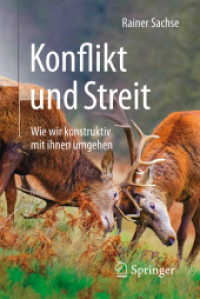- ホーム
- > 洋書
- > ドイツ書
- > Humanities, Arts & Music
- > Arts
- > architecture
Full Description
Urban Design Methods is a manual for reconciling contemporary approaches with increasingly complex demands in the shaping of urban living spaces. Architects and landscape architects, as well as city, regional, and landscape planners, often find that they are unable to do modern projects justice with their specialist skills alone. Cooperative approaches are needed to deal with both the complexity of raising questions and the growing number of affected parties who need to be involved. Urban design—understood as an inter- and transdisciplinary field at the interface of architecture, city and regional planning, landscape architecture, sociology, and the diverse stakeholders involved in any project—requires a compendium of adaptable methods to dissolve the boundaries between theory and praxis and between natural and social systems. For the first time, this book collects a broad spectrum of methods intended to support urban designers in deciphering the contexts in which they work, and help them attain a greater individual professional understanding. It clearly outlines the range of challenges and the constantly evolving areas of activity.
Contents
Frontmatter -- Contents -- # A.1 urban design as a changing profession -- # A.2 some notes about interdisciplinarity -- # A.3 external statements -- # A.4 working across geographical boundaries: reflecting on sino-german cooperation in urban design -- # B. how to read this book -- Introduction -- # B.1 understanding spatial practices -- # B.2 diagrammatic sketching -- # B.3 unpacking discourses -- # B.4 experimenting -- # B.5 interviewing experts -- # B.6 mapping spatial systems -- # B.7 urban data mining -- # B.8 analyzing pictures -- # B.9 using questionnaires -- # B.10 applying ANT -- # B.11 understanding typologies and morphologies -- # B.12 viewing the urban through an ethnographic lens -- # B.13 analyzing and visualizing actors -- # B.14 getting lost: unfolding creative thinking -- # B.15 narrating through graphics -- # B.16 adding, dividing, superimposing -- # B.17 creating conceptual models -- # B.18 intervening through system thinking -- # B.19 designing grid principles -- # B.20 producing and reducing complexity -- # B.21 engaging humans and nonhumans in design -- # B.22 building knowledge through charrettes -- # B.23 participation and enactment games -- # B.24 visualizing possible futures -- # B.25 urban coding -- # B.26 curating evolutionary landscapes -- # B.27 co-designing and building -- index of authors -- imprint








